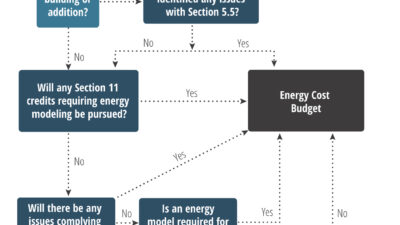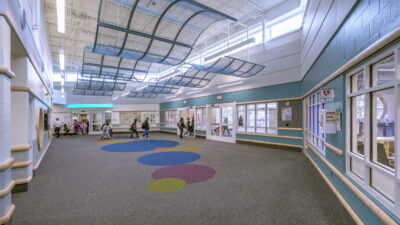View the full story, including all images and figures, in our monthly digital edition
Like many other things around us, school cooking operations seem to be continuously changing. Complete model shifts from independent full-cooking kitchens to centralized cooking facilities and satellite (reheat and ladle) operations are happening everywhere. Also, the evolution in menus to accommodate society’s focus on health-conscious eating, food allergies, and general concerns for proper nutrition has made it necessary for school cooking facilities to change in unison.
As we engineer these systems, we can’t help but wonder how these changes affect the lifecycle of the kitchen ventilation system—or, rather, how we can design to ensure more flexibility and sustained equipment life.
Many products and design choices can be made to create more flexibility now and in the future. Three simple product choices in particular have proven to be of great value.
Exhaust-only hoods: Install exhaust-only hoods (hoods that do not have built-in supply plenums) whether they are placed against a wall or in a back-to-back island configuration. These hoods offer the largest capture tank and thus perform better. Furthermore, they allow complete flexibility (now and in the future) for the supply solution, whether air is introduced through perforated ceiling diffusers, external supply plenums around the hood, or otherwise.
Fire suppression systems: The most commonly used fire suppression systems provide appliance-specific protection, meaning a fryer and a griddle each have a unique protection solution with a specific nozzle choice and location to protect each appliance. If the two appliances are rearranged or the type of appliance is changed, that protection is no longer valid. This requires a certified installer to come to the facility and modify the system, which may cost anywhere from a few hundred to thousands of dollars, depending on the change. The alternative is to use what is commonly referred to as overlapping or full-flood protection. Overlapping protection provides protection across the entire length of the hood, regardless of equipment type, with few exceptions, allowing equipment to be changed or moved without major rework to the system. Two very reliable manufacturers of these systems are Amerex and Ansul.
Utility distribution systems: In any kitchen, utilities need to be supplied to the varying cooking batteries whether they are electric, gas, steam, or water. Typically, a wall is built and lines are run to provide these utilities at each appliance. When changes occur, several trades are required to move a gas connection, run new wires, refinish the wall, etc. A utility distribution system (UDS), which a variety of hood manufacturers offer, is an Underwriters Laboratories (UL)-listed, pre-engineered, pre-wired, pre-piped, and pre-tested system that saves time and money and maintains flexibility. Some UDS manufacturers have gas and water lines that have standard drop locations. For example, gas drops every 12 in. almost guarantee that there will be a drop where needed without modification. UDS electrical panels are easy to access, making changing out breakers or outlets easy. Furthermore, if the facility moves or is rearranged, utility distribution systems can be moved easily.
Incorporating these three products into a school cooking operation will make it easier to change equipment without having to make substantial changes inside the building walls. However, if exhaust and supply airflow requirements change, fans and makeup air units may require replacement or adjustment.
Figure 1: Constant volume: This example shows how a constant volume system operates at 100% all day even though the actual cooking load varies. Source: Greenheck Fan Corp.
Energy-saving products
Recognizing that that cooking loads vary throughout the day, variable volume systems can greatly reduce lifecycle costs by generating significant savings. These systems monitor the cooking operation and adjust the exhaust, supply, and rooftop unit fans so when the cooking load is reduced, the fans operate at a reduced level and save energy, especially considering heating and cooling loads. These systems typically use a mechanism to sense the heat load from the cooking equipment and send a signal back to the controls system, which then provides a signal to a variable frequency drive (VFD) that adjusts the fan speed.
Another way to save energy and increase the lifecycle through flexibility is by using electrically commutating motors on direct-drive fans that are UL 762 listed for cooking applications. These motors have up to 80% usable turndown with significant power use reductions, no belt or pulley losses, no belt maintenance, and no requirement for a VFD to adjust the speed of the fan. These motors also soft start, increasing motor life, and run much cooler than typical motors or permanent-split capacitor motors, extending bearing life.
Maintenance
As with cars and many other products we rely on every day, preventive maintenance is critical to extending the life of the system. The most important type of maintenance, especially for centralized or full cooking operations, is routine filter cleaning. Filters need to be cleaned frequently—even daily—depending on the cooking loads. Cleaning will maintain lower static pressures in the system, thus reducing additional load on the fan. Also, keeping filters clean will facilitate efficient operation and reduce the amount of grease in the ductwork and fans. Grease buildup on fans can lead to unbalanced operation and premature motor and bearing failure.
Duct and hood cleaning must be routine and scheduled at a frequency that matches the cooking operation and filter efficiency. That is, more volatile cooking operations require more frequent cleaning, and more efficient filters can help reduce the frequency of cleanings.
Belts on fans should be inspected and replaced as necessary during duct cleanings, and makeup air filters also should be changed regularly.
Lastly, as many schools are seasonal, kitchen ventilation system maintenance also is recommended at the end of the school year and before school starts again. This provides a chance to clean the system, ensure that things are in good working order for summer events, and eliminate any surprises on the first day of school.
| Author Information |
| Rivet is product manager – kitchen ventilation systems with Greenheck. His expertise lies in effective and efficient kitchen ventilation design and product application, and he is a member of NFPA. |



